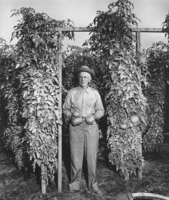 | Back to e-WV
| Back to e-WV
 The West Virginia Encyclopedia
The West Virginia Encyclopedia
 | Back to e-WV
| Back to e-WV
 The West Virginia Encyclopedia
The West Virginia Encyclopedia

For a long time after Europeans settled here, most West Virginians were farmers. As many became miners and loggers, sawyers, and shopkeepers in the late 1800s and early 1900s, most families continued to keep a kitchen garden to supplement the wages the husband was bringing in and tide the family through the occasional short work weeks, layoffs, and strikes. By the 1950s, many West Virginians were making decent wages working in unionized mines and in steel, chemical, and glass plants but still clung to a connection to the land. Many commuted to work from hilltop or hollow homes where they continued to run cattle, cut hay, and plant a vegetable garden. Others moved to small towns, where the house lot was often big enough to accommodate a substantial garden.
Vegetable gardens hung on in West Virginia long after most West Virginians needed them to get by. Gardening was in the culture, and families were going to plant six or eight long rows of ‘‘Irish’’ potatoes, some sweet potatoes, too, and a row of Late Flat Dutch cabbage. That is what their parents and grandparents had done, and they wanted to stay connected to that. They grew plenty of tomatoes, sweet peppers and hot peppers, also some sweet corn for roasting ears and cucumbers for fresh eating and pickles. They planted enormous stretches of beans, a few bush beans for early eating, and pole beans or their beloved halfrunners for canning.
A kitchen was a busy and exceedingly hot place in summer as women made the pickles and sauerkraut, then canned them along with all the beans and tomatoes. West Virginians grew onions from sets, and some Black-seeded Simpson lettuce for harvest in spring. They grew a few pumpkins or winter squash for winter, and maybe they planted an extra row of sweet potatoes for storage, too. In July or August, they sowed a bed of turnips, the turnip greens for fall cooking and the turnips for storage in the root cellar beside the potatoes and canned goods.
West Virginians weren’t likely to grow much eggplant, cauliflower, or asparagus, but they usually had a few rhubarb plants which returned to life each spring and made tangy stalks for pies. They sometimes planted a row of peas, and in modern times maybe some summer squash and broccoli. They weren’t likely to plant blueberries, but they picked the wild raspberries and blackberries and turned them into pies and preserves. An apple tree stood beside the house, and the apples went into pies, apple sauce, and apple butter.
Over the years, gardens have shrunk in size, rendered superfluous by the continuous harvest that the modern supermarket brings in from distant lands. Gardeners have also had to work around a problem that didn’t exist in the state until the mid-1970s, and in some southern counties until the mid- or late 1980s. That is the white-tailed deer. Farmers had always had to contend with the pesky groundhog, which a big dog could kill with a shake, and with the nocturnal raccoon, which fortunately ate just the roasting ears. But as deer multiplied, the entire garden became a feeding ground. Deer could ravage a garden and consume the entire crop, and the same state that declared groundhogs varmints protected deer.
Discouraged gardeners quit gardening and determined ones put up tall fences, electric fences, or seven-foot-high deer netting. Many resorted to that old standby, a good-size dog. As more West Virginians live in cities and fancy subdivisions, and as they become two or three generations removed from their rural roots, many people grow nothing edible or perhaps just a few tomato plants. Those who still want a good tomato or a sweet roasting ear patronize the truck farmers and market gardeners who raise tomatoes, corn, squash, cucumbers, and peppers and sell them along the roadside or at farmers’ markets.
Written by Bob Schwarz